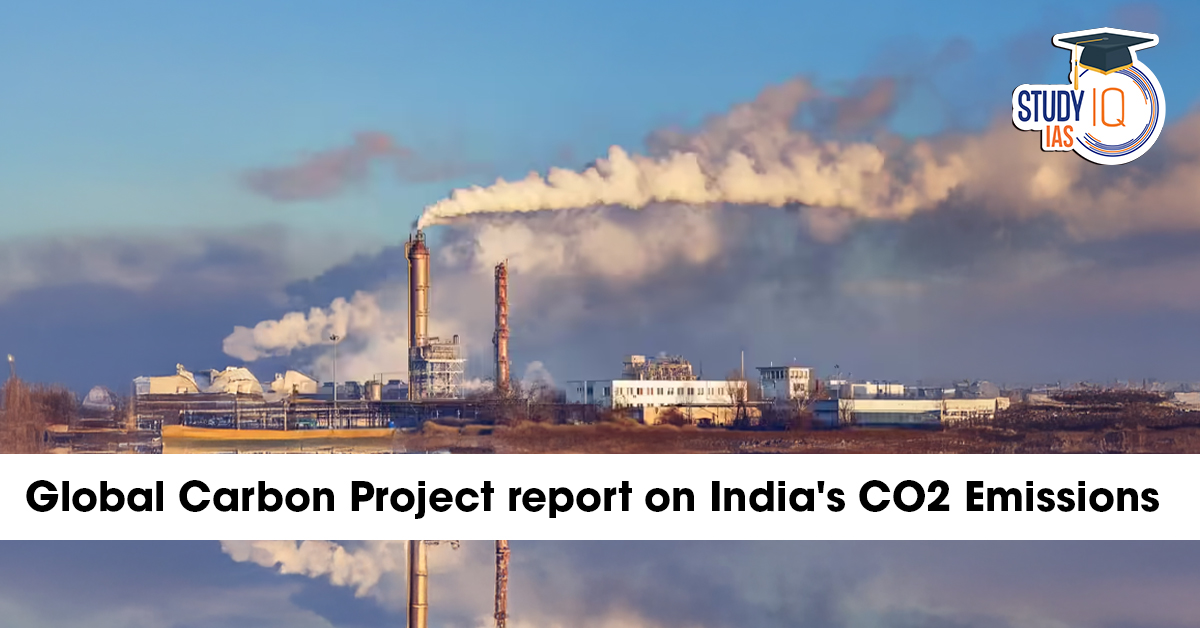Table of Contents
The latest Global Carbon Project (GCP) report reveals a major shift in India’s emissions trajectory. According to the 2025 Global Carbon Budget, India’s CO₂ emissions from fossil fuels are expected to rise by only 1.4%, a significant drop from the 4% growth recorded in 2024. This slowdown highlights the combined impact of early monsoon conditions, strong renewable energy expansion, and reduced coal consumption across the country.
This article explains the key findings, trends, reasons behind the slowdown, and India’s position in the global emissions landscape.
What Is the Global Carbon Project (GCP)?
The Global Carbon Project is an international scientific collaboration that analyzes:
-
Global carbon emissions
-
Carbon sinks
-
Trends in fossil fuel use
-
Land-use changes
Every year, GCP publishes the Global Carbon Budget—a highly trusted and widely used scientific estimate, also featured in the Nature journal. The 2025 report coincides with COP30, held in Brazil.
Key Highlights of India’s CO₂ Emissions (2025 Report)
1. Growth rate slows to 1.4%
-
2024 emissions: 3.19 billion tonnes CO₂-eq
-
2025 estimated emissions: 3.22 billion tonnes CO₂-eq
-
Growth: 1.4%, the slowest rate in years
2. Sharp drop from last year
-
2024 growth: 4%
-
2025 growth: 1.4% = major deceleration
3. India’s emissions growth lower than the US
The United States is forecast to see a 1.9% increase in fossil CO₂ emissions in 2025, partly linked to policy shifts under the Trump administration.
4. Renewable energy and early monsoon played key roles
According to GCP:
-
Early monsoon → reduced cooling demand
-
Expanded renewable energy → lower coal consumption
-
Less power required for irrigation during monsoon
Sector-Wise Breakdown of Fossil Fuel CO₂ Emissions
Fossil-related emissions come from:
-
Electricity generation
-
Industry
-
Transportation
-
Buildings & heating
These sectors account for ~90% of global CO₂ emissions.
The remaining 10% comes from land-use change, such as:
-
Deforestation
-
Land clearing
-
Degradation of natural ecosystems
Long-Term Trend: India’s Emissions Growth Declining
The GCP report highlights a clear long-term downward trend:
Decadal average growth of CO₂ emissions:
-
2015–2024: 3.6%
-
2005–2014: 6.4%
This slowdown is due to:
-
Expanding economic base
-
Lower carbon intensity
-
Increased renewable energy share
-
Improvements in energy efficiency
Independent Studies Support the Slowdown
A separate study by Centre for Research on Energy and Clean Air (CREA) for Carbon Brief (UK) found:
-
For the first time, India’s electricity-sector CO₂ emissions declined in the first half of the year compared to the previous year.
-
Reason: Good monsoon, which lowered cooling and irrigation loads.
Global Context: Emissions Still Rising
-
Global CO₂ emissions from fossil fuels are expected to rise 1.1% in 2025 to reach a record 38.1 billion tonnes.
-
Land-use CO₂ emissions are projected to decline, helping global CO₂ emissions remain relatively flat at ~42 billion tonnes.
Despite climate action, global fossil emissions remain on an upward trajectory.
What This Means for India
Positive Indicators
-
India is gradually decoupling economic growth from emissions, a crucial climate milestone.
-
Expanded renewable capacity (solar, wind) is reducing dependence on coal.
-
Better monsoon patterns helped reduce cooling loads.
Challenges
-
Coal still dominates India’s energy mix.
-
Growing industrialization and transport demand may increase emissions in the future.
-
Land-use emissions still need stronger governance.
Conclusion
The Global Carbon Project’s 2025 report marks an important moment in India’s climate pathway. With fossil CO₂ emissions expected to grow at just 1.4%, India demonstrates strong progress in reducing carbon intensity and accelerating renewable energy adoption.
However, sustained policies, stronger climate action, and large-scale clean energy deployment will be essential for India to maintain this downward trajectory and achieve long-term climate goals.


 Hydrogen Valley Innovation Clusters (HVI...
Hydrogen Valley Innovation Clusters (HVI...
 Key Methods of DNA Identification: Techn...
Key Methods of DNA Identification: Techn...
 State of the Cryosphere 2025 Report: Key...
State of the Cryosphere 2025 Report: Key...

























